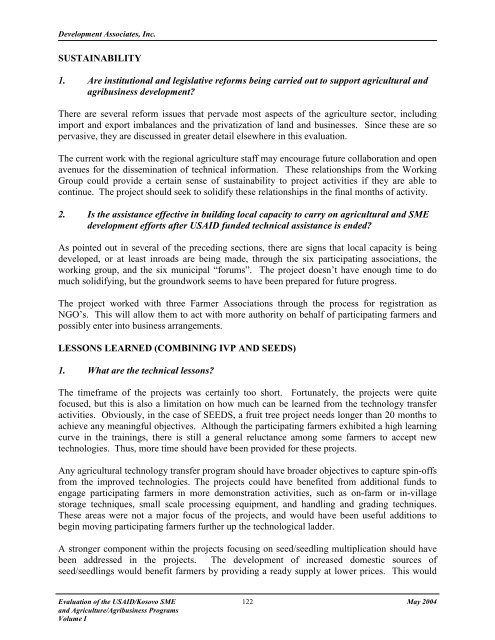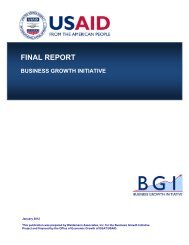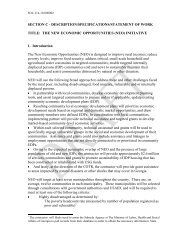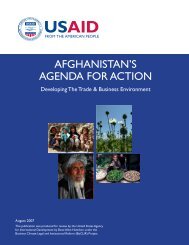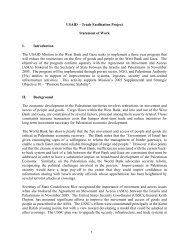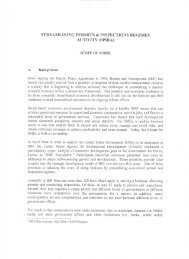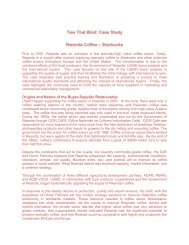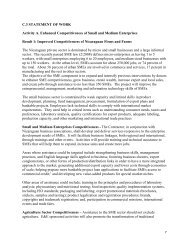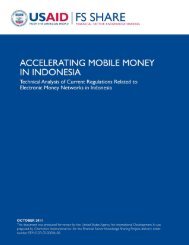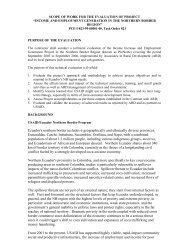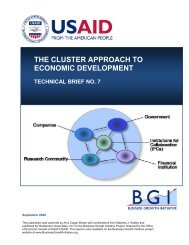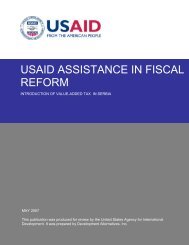Evaluation of the USAID-Kosovo SME and Agriculture - Economic ...
Evaluation of the USAID-Kosovo SME and Agriculture - Economic ...
Evaluation of the USAID-Kosovo SME and Agriculture - Economic ...
Create successful ePaper yourself
Turn your PDF publications into a flip-book with our unique Google optimized e-Paper software.
Development Associates, Inc.SUSTAINABILITY1. Are institutional <strong>and</strong> legislative reforms being carried out to support agricultural <strong>and</strong>agribusiness development?There are several reform issues that pervade most aspects <strong>of</strong> <strong>the</strong> agriculture sector, includingimport <strong>and</strong> export imbalances <strong>and</strong> <strong>the</strong> privatization <strong>of</strong> l<strong>and</strong> <strong>and</strong> businesses. Since <strong>the</strong>se are sopervasive, <strong>the</strong>y are discussed in greater detail elsewhere in this evaluation.The current work with <strong>the</strong> regional agriculture staff may encourage future collaboration <strong>and</strong> openavenues for <strong>the</strong> dissemination <strong>of</strong> technical information. These relationships from <strong>the</strong> WorkingGroup could provide a certain sense <strong>of</strong> sustainability to project activities if <strong>the</strong>y are able tocontinue. The project should seek to solidify <strong>the</strong>se relationships in <strong>the</strong> final months <strong>of</strong> activity.2. Is <strong>the</strong> assistance effective in building local capacity to carry on agricultural <strong>and</strong> <strong>SME</strong>development efforts after <strong>USAID</strong> funded technical assistance is ended?As pointed out in several <strong>of</strong> <strong>the</strong> preceding sections, <strong>the</strong>re are signs that local capacity is beingdeveloped, or at least inroads are being made, through <strong>the</strong> six participating associations, <strong>the</strong>working group, <strong>and</strong> <strong>the</strong> six municipal “forums”. The project doesn’t have enough time to domuch solidifying, but <strong>the</strong> groundwork seems to have been prepared for future progress.The project worked with three Farmer Associations through <strong>the</strong> process for registration asNGO’s. This will allow <strong>the</strong>m to act with more authority on behalf <strong>of</strong> participating farmers <strong>and</strong>possibly enter into business arrangements.LESSONS LEARNED (COMBINING IVP AND SEEDS)1. What are <strong>the</strong> technical lessons?The timeframe <strong>of</strong> <strong>the</strong> projects was certainly too short. Fortunately, <strong>the</strong> projects were quitefocused, but this is also a limitation on how much can be learned from <strong>the</strong> technology transferactivities. Obviously, in <strong>the</strong> case <strong>of</strong> SEEDS, a fruit tree project needs longer than 20 months toachieve any meaningful objectives. Although <strong>the</strong> participating farmers exhibited a high learningcurve in <strong>the</strong> trainings, <strong>the</strong>re is still a general reluctance among some farmers to accept newtechnologies. Thus, more time should have been provided for <strong>the</strong>se projects.Any agricultural technology transfer program should have broader objectives to capture spin-<strong>of</strong>fsfrom <strong>the</strong> improved technologies. The projects could have benefited from additional funds toengage participating farmers in more demonstration activities, such as on-farm or in-villagestorage techniques, small scale processing equipment, <strong>and</strong> h<strong>and</strong>ling <strong>and</strong> grading techniques.These areas were not a major focus <strong>of</strong> <strong>the</strong> projects, <strong>and</strong> would have been useful additions tobegin moving participating farmers fur<strong>the</strong>r up <strong>the</strong> technological ladder.A stronger component within <strong>the</strong> projects focusing on seed/seedling multiplication should havebeen addressed in <strong>the</strong> projects. The development <strong>of</strong> increased domestic sources <strong>of</strong>seed/seedlings would benefit farmers by providing a ready supply at lower prices. This would<strong>Evaluation</strong> <strong>of</strong> <strong>the</strong> <strong>USAID</strong>/<strong>Kosovo</strong> <strong>SME</strong> 122 May 2004<strong>and</strong> <strong>Agriculture</strong>/Agribusiness ProgramsVolume I


